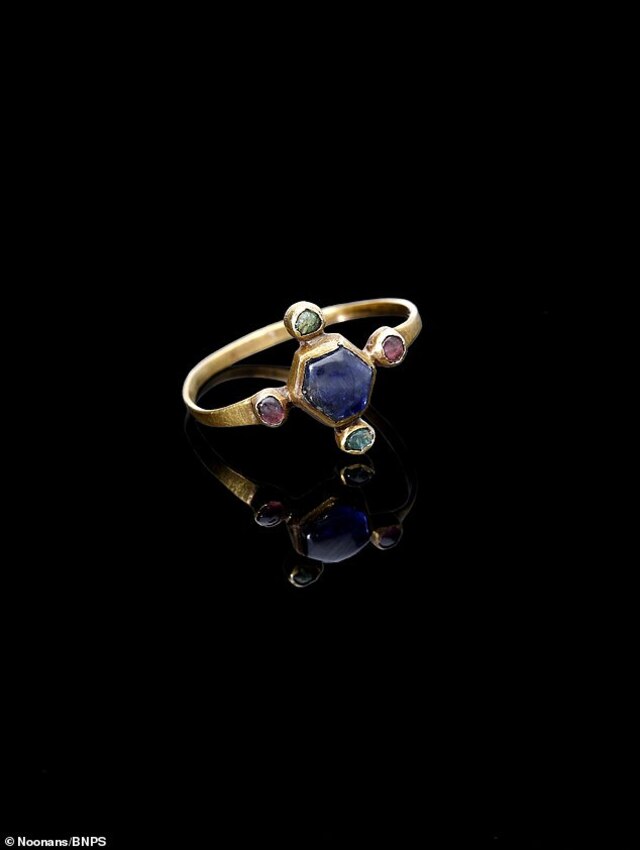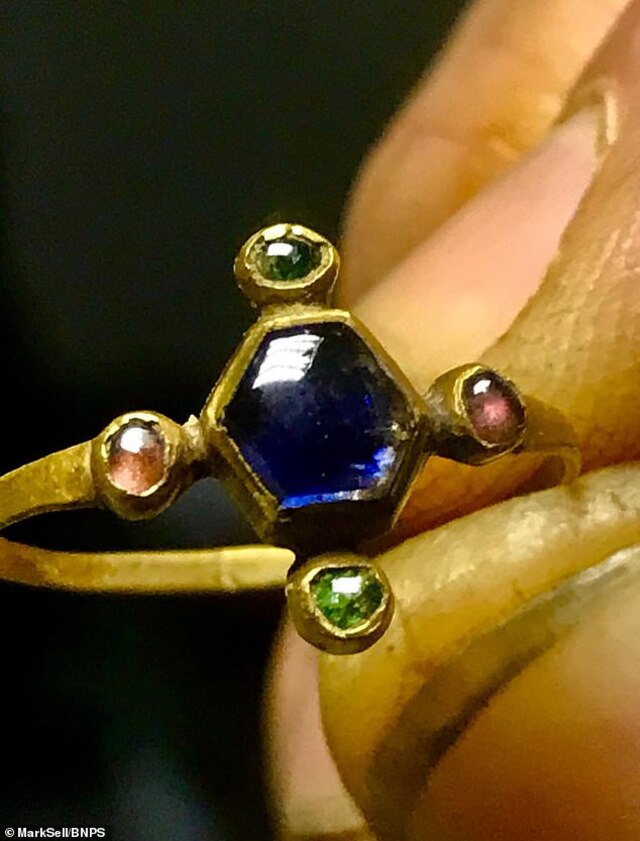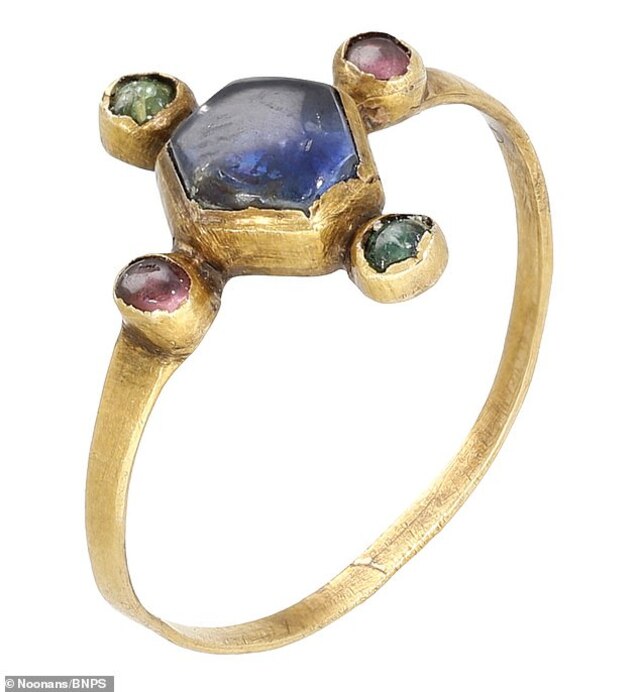In the historic village of Shipdham, Norfolk, a rare and extraordinary discovery was made that promises to captivate both history enthusiasts and collectors alike. Metal detectorist Mark Sell unearthed a medieval ring that is believed to have once belonged to a bishop, dating back to the late 12th or early 13th century. This remarkable find, now known as the “King Row Ring,” is set to fetch a remarkable price of £18,000 at auction, providing a glimpse into the wealth and intricacies of the medieval period. Despite its relatively modest origins, this discovery offers valuable insights into the religious and political landscape of the time, particularly the role of bishops in medieval society.
The Details of the Discovery
Mark Sell, a retired firefighter and passionate metal detectorist, was no stranger to searching the fields of Shipdham when he made the stunning find. On a seemingly ordinary day, as dusk approached, he received a faint signal on his metal detector. Digging down approximately nine inches into the muddy earth, he uncovered what would become one of his most significant discoveries. The gleaming, golden ring emerged from the clod of mud, its intricate design and gemstones still intact after nearly 800 years.

As Sell wiped away the dirt, he was struck by the sight of a finely crafted medieval gold ring, complete with a large sapphire in the center, surrounded by emeralds and garnets. The ring’s preservation was remarkable, and it immediately became clear that this was no ordinary find. The craftsmanship of the ring suggested it had been created for someone of high rank, possibly a bishop. The ring’s original gemstones, particularly the sapphire, were a testament to the wealth and status of the wearer, marking it as an extraordinary relic from a bygone era.
Video
Watch the video about a medieval bishop’s sapphire ring going up for auction, expected to fetch £18,000 in the UK.
Historical Context of the Bishop’s Ring
Dating back to the late 12th or early 13th century, the ring is believed to have been worn by a bishop, a prominent figure in the medieval church. During this period, bishops were not only religious leaders but also political and cultural figures who wielded significant influence. The ring’s design, with its central sapphire surrounded by smaller garnets and emeralds, is a hallmark of the type of jewelry typically associated with bishops in medieval England.

The connection to bishops is further supported by the historical context of the time. During the early 13th century, powerful bishops such as Walter de Grey, the Archbishop of York, were known to have worn similar rings. In fact, one such ring belonging to de Grey is displayed at York Minster today. The style of the Shipdham ring, with its signature combination of sapphire and surrounding gemstones, aligns perfectly with the rings worn by these influential churchmen, offering a tantalizing glimpse into the wealth and power they held.
The Role of Shipdham and Its Significance
The village of Shipdham itself plays a pivotal role in the story of the King Row Ring. Known as a well-established settlement by the time of the Norman Conquest, Shipdham was recorded in the Domesday Book of 1086, a testament to its importance in medieval England. During the 13th century, Shipdham was home to the Bishop of Ely, a significant ecclesiastical figure during the reign of King Henry III. The possibility that the ring belonged to the Bishop of Ely or another influential church leader adds another layer of intrigue to this discovery.
The location of Shipdham, with its rich historical background, adds to the ring’s significance. As a settlement detailed in the Domesday Book, Shipdham’s role as a center of commerce and religion during medieval times is well-documented. The presence of such a high-status object, buried in the fields of Shipdham, suggests that the area may have been a site of political and religious importance, where wealth and power intersected. The discovery of the ring, therefore, may offer valuable clues about the social and political dynamics of 13th-century Norfolk.

The Auction and Expected Price
Following its discovery, the King Row Ring has attracted significant attention, and its eventual sale is expected to raise a substantial amount at auction. Auctioneers Noonans in Mayfair, London, have estimated that the ring will sell for between £15,000 and £18,000. This price reflects not only the ring’s rarity but also its historical and cultural value. Given its impeccable preservation and its connection to a period of immense religious and political influence, the ring is poised to become a prized artifact for collectors and historians alike.
The auction process also highlights the importance of the ring as a piece of cultural heritage. Mark Sell, having reported his find to the local Finds Liaison Officer, adhered to the legal requirements, ensuring that the ring was properly documented and displayed at both the British Museum and Norwich Castle Museum. The ring’s eventual sale is not just a financial transaction but also a testament to the ongoing efforts to preserve and study historical artifacts.

The Fascination with Medieval Artifacts
Medieval artifacts such as the King Row Ring offer us an invaluable connection to the past. Objects like these provide insight into the lives of people who lived centuries ago, offering clues about their social status, religious practices, and daily lives. The discovery of such a rare and well-preserved piece of jewelry allows us to better understand the material culture of medieval England, particularly the relationship between the church and the nobility.
The fascination with medieval artifacts is not merely about the monetary value they can fetch but also about the stories they tell. The King Row Ring, with its exquisite craftsmanship and association with the powerful bishops of the time, represents more than just a piece of jewelry; it is a tangible link to a world long gone but not forgotten. By studying these artifacts, archaeologists and historians can piece together the complex narrative of medieval society, shedding light on the lives of those who shaped history.
Video
Watch the video about the “beautiful” 185-year-old Victorian ring with a hidden secret, featured on Antiques Roadshow.
Conclusion: Preserving the Past for Future Generations
As the King Row Ring prepares to be auctioned off, it serves as a reminder of the importance of preserving and studying historical artifacts. The discovery of such objects not only enriches our understanding of the past but also ensures that future generations will be able to learn from and appreciate the cultural heritage left behind by those who came before us.
The ring’s sale will undoubtedly generate significant interest, but its true value lies in the insights it offers into medieval society. Whether it was worn by a bishop, used in religious ceremonies, or passed down as a treasured heirloom, the King Row Ring remains a symbol of the wealth, power, and influence of the medieval church. As we look to the future, it is essential to continue our efforts to protect and study these remarkable pieces of history, ensuring that the stories they tell are never forgotten.



